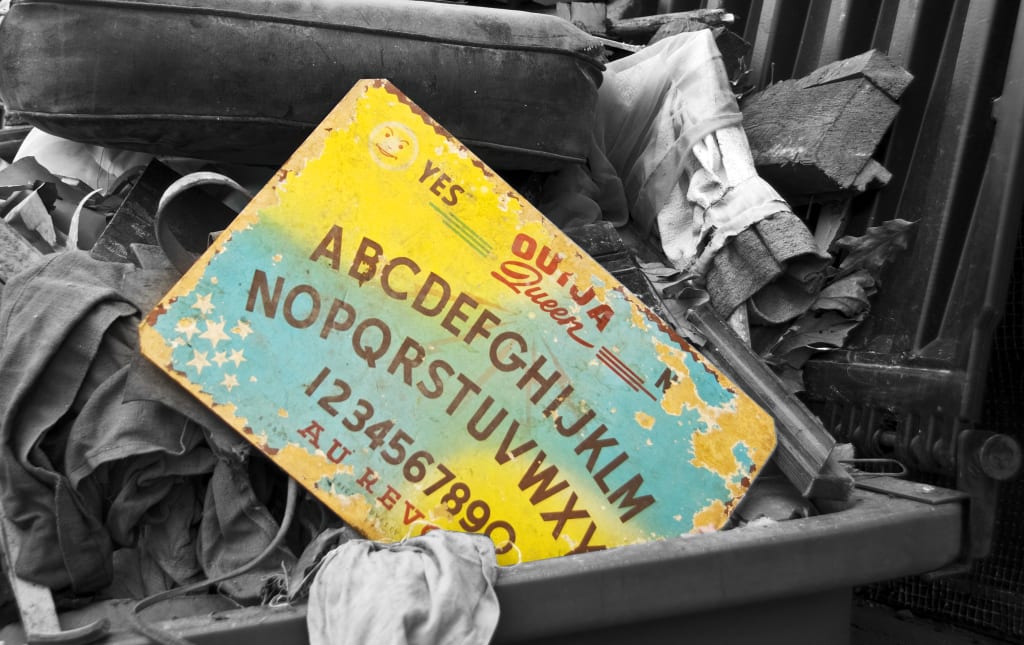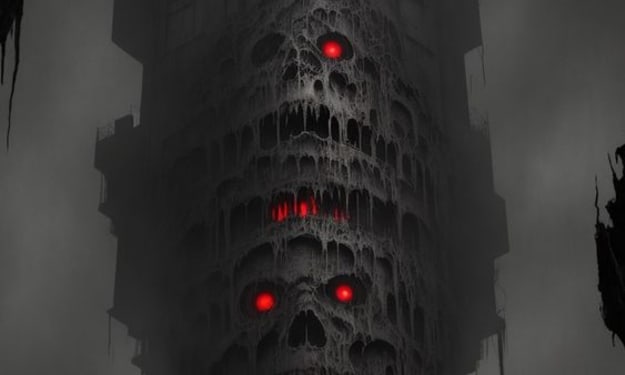Why Does Hasbro Make Ouija Boards?
Seriously. Hasbro makes these things. Look it up.

Hasbro Inc. is one of the best known toy companies in the entire world. They are responsible for manufacturing Nerf products, Baby Alive dolls, the Easy Bake Oven, and beloved board games such as Candy Land and Clue. Founded in 1923, the company has been manufacturing childhoods for almost 100 years. So it might surprise you to discover what else they manufacture.
Ouija boards.
You heard me right. This prolific toy company makes the board that is reported to be a portal for demonic possession. They currently hold all patents and trademarks associated with the board, and they have recently released a new one in shades of pink—obviously your tools for contacting the dead have to appeal to little girls too.
So what led to Hasbro having the rights to a powerful tool of the supernatural? Let's take a look.
Automatic Writing
The first mention of automatic writing using a planchette—basically the technique used with most Ouija boards—is found in China in 1100 AD. Back then, the method was known as "fuji" which translates roughly to "planchette writing." This technique, used as a means of both necromancy and general communication with the spirit world, was mainly practiced by the Quanzhen School, until it was eventually banned under the Qing Dynasty. Some speculate that similar methods of "spirit writing" were used in India, Greece, Rome, and even medieval Europe, though the evidence for this claim is sparse.
Spiritualism
The Ouija board—also known as a talking board or a spirit board—as we know it was born in the 19th century spiritualist movement. Immediately following the American Civil War, mediums began doing big business with survivors, allowing them to contact dead loved ones. But the methods of communicating with the dead at the time—like the knocking method employed by the infamous Fox Sisters in New York—was notoriously slow, and people began searching for a faster way for spirits to communicate with them. The talking board was the perfect solution; there was no waiting for a number of knocks that would correspond to a letter of the alphabet, just the movements of the planchette on the board. Though the Ouija board itself wouldn't be created until 1890, talking boards had become so popular that there were reports in 1886 that the technique was "taking over" spiritualist camps that had popped up in Ohio.
Going Commercial
According to the patent, Elijah Bond, a businessman, attorney and inventor, came up with the idea to patent a planchette that would be sold with a board printed with the alphabet—the basic design of many talking boards that already existed. He, Charles Kennard (the founder of the Kennard Novelty Company, which was initially manufacturing the boards) and a surveyor named Col. Washington Bowie were the initial investors, and they filed for patent protection on May 28, 1890—thus, they are credited with inventing the Ouija board, even though such a thing already existed at the time. They received US Patent 446,054 on February 10, 1891. According to Charles Kennard, he was using the board with a group of others—including Elijah Bond's sister-in-law, Helen Peters. They asked the board what they should call it and received the response "Ouija"—when they asked what it meant, the board reportedly said "Good luck." However, Peters admitted that she was wearing a locket at the time that contained a photo of a woman with the name "Ouija" above her head. Researchers think that it is very possible that the photo was of a famous author and women's rights activist named Ouida, and "Ouija" was simply a misreading of that.
The board, and all of the knockoffs that came out of the woodwork upon its creation, was so successful that by 1892, the Kennard Novelty Company had expanded from a single factory in Baltimore, Maryland to two in Baltimore, two in New York, two in Chicago, and one in London. It was regarded both as a tool for communing with spirits and a fun parlor game for families; after all, talking with the dead was incredibly common in the time period, and most people were not perturbed when their Great Grandma Edie started moving the planchette around. This craze would span from the 1920s into the 60s, even after the board became a symbol of the occult after Pearl Curran, a prominent spiritualist, began using it during WWI.
Passing the Torch
In 1901, an employee of Bond's named William Fuld had taken over the Ouija business. Some say that he even rewrote the board's history, claiming that he had invented it, but upon closer inspection, there is no evidence that he ever made such statements. In 1919, Col. Washington Bowie, the final shareholder (at this point Bond and Kennard had already gotten out) sold his remaining shares in the company to Fuld for $1, making him the sole owner of the Ouija empire. Fuld's name would become deeply intertwined with the Ouija board, and he would sue many companies over the name and concept—right up until his tragic death in 1927, when he fell from the roof of a new factory—a factory that a Ouija board had supposedly told him to build.
Fuld's estate would hang on to the business until 1966, when it was sold to Parker Brothers, which would then sell the Ouija product line and all of its affiliated rights to Hasbro in 1991. Currently, all patents and trademarks related to the Ouija board belong to Hasbro Inc, though around ten different brands sell talking boards today, under a variety of names.
Today
Currently, you can purchase a Ouija board on the Hasbro website for $19.99—a paltry price for the possibility of losing your immortal soul. The product is rated for ages 8 and up, but the board has earned a sinister reputation in its thousands of years of existence. Books, comics, movies, and television have turned the Ouija board from a family-friendly board game into a portal for all sorts of evil. Often, the use of such a device is the reason that families become haunted, or houses, objects, and people become possessed. Many Christian denominations warned against the board from the beginning, but practitioners of the occult are divided; some state that any possession resulting from the use of a Ouija board is a positive transformation and ultimately temporary, while others echo the Christian warnings—how ironic is that?—and discourage inexperienced users from attempting to contact anyone—or anything—using the device.
Though the Ouija board is a board game marketed for children, there have been many famous adults associated with its use.
Bill Wilson, the founder of Alcoholics Anonymous, was said to use one regularly during his seances, in which he would attempt to contact various deceased individuals.
Aleister Crowley, a pop icon of the occult, was reported to have great respect for the boards, and would use them passingly in his various rituals.
And, probably most notably, early press releases would state that the stage name of Vincent Furnier, Alice Cooper, was agreed upon after using a Ouija board that revealed that Furnier was a reincarnation of a 17th century witch of the same name. Later on, Furnier would admit that he just blurted the first name that came to his head while discussing it with the band. Personally, I think that the first story gives them a little bit more street cred.
About the Creator
Skylar Banach
I'm a freelance writer with an interest in true crime, entertainment, and a wide range of other things.
My avatar was created on Picrew with a generator created by the very talented Hunbloom!







Comments
There are no comments for this story
Be the first to respond and start the conversation.